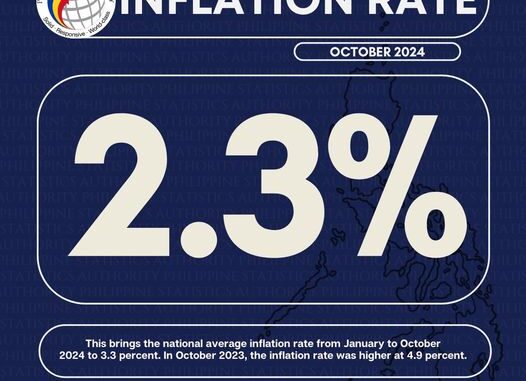
Inflation rate in the Philippines picked up to 2.3 percent in October 2024 from 1.9 percent in September following the onslaught of storms on farms and logistics, data from the Philippine Statistics Authority (PSA) show.
The National Economic and Development Authority (NEDA) said despite the uptick in October, prices remain stable.
“The latest inflation figures confirm that we are on track to keep inflation within target. The government is fully committed to ensuring price stability and protecting Filipino households from undue shocks,” said NEDA Secretary Arsenio Balisacan.
Inflation averaged 3.3 percent in the first 10 months of 2024, within the government’s target range of 2.0 to 4.0 percent for the year.
NEDA said the increase in October was driven by higher inflation in food and non-alcoholic beverages, which rose to 2.9 percent from 1.4 percent in the previous month. Rice inflation accelerated to 9.6 percent from 5.7 percent, with retail prices remaining elevated relative to the same period last year, while prices have been easing month-on-month.
Meat inflation remained stable, as pork prices registered lower inflation of 3.5 from 3.7 percent in the previous month. The Department of Agriculture expanded its vaccination program against African swine fever to include commercial farms and swine herds under the Integrated National Swine Production Initiatives for Recovery and Expansion (INSPIRE) Program.
The number of infected zones declined to 505 as of Oct. 18 from 534 on Oct. 2.
“Recent weather disturbances, including Typhoon Kristine, have posed significant challenges to our food supply and logistics. The government is working relentlessly to keep food available and prices steady, particularly for essential commodities. With targeted support and streamlined food supply chains, we aim to ensure that food is affordable and accessible for Filipino families, especially those most vulnerable to price shocks when disasters hit us,” Balisacan said.
The Philippine Atmospheric, Geophysical, and Astronomical Services Administration forecasts that La Niña will persist until the first quarter of 2025, with two to eight tropical cyclones expected to affect the country until April 2025.
To mitigate the impact of natural disasters, the Department of Social Welfare and Development is implementing the Building on Social Protection for Anticipatory Action and Response in Emergencies and Disasters (B-SPARED) Program. This initiative provides social safety nets and capacity-building measures to support affected communities.
“The President has mobilized all of government to ensure relief efforts are comprehensive and delivered on time. In addition, he has directed us to craft a robust solution to build the resilience of families and communities amid the onslaught of severe typhoons,” Balisacan said.


Be the first to comment